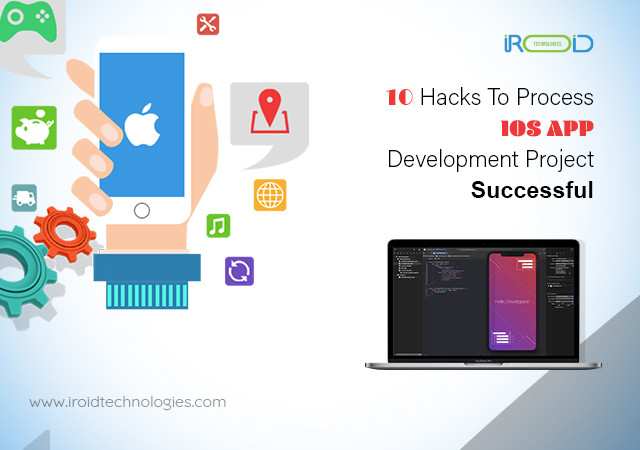10 Hacks To Process iOS App Development Project Successful

You can find the most useful exercises in every industry. They are precepts of thumb for doing critical things in a quite desirable way. Professionals assume them with years of experience and accord them among their business. It's not complex in IT and software development. However, repaying it is to receive everything on your own, there is an even greater way. Observe and discover other people's errors. This is why we are determined to put together these 10 customs that will help you build even more excellent iOS apps.
Alright, now is the opportunity to experience the best systems and golden practices you should combine in your iOS app development process. It will not perpetually be simple, but it's definitely deserving of it.
1. Arrange for the battle
Many developers feel an overwhelming urge to start coding directly. Although it's an acceptable strategy, it's not the most desirable one. Making an application is a complicated process and you can occasionally skip a phase without results. Before your team begins coding, you demand to settle on the app's architecture and which design guides to choose. Typically, for the iOS app development process, you will accept a Model-view-controller design. In MVC, you crack down the application into elements of UI, Data, and Software. It has the further advantage of serving your app for coming developments and upgrades.
2. Create and support the documentation
You should have adequate documentation comprising all components of the system. A summary of the coveted project consequence will assist you to keep on course. Documentation of code will next be an unbelievable source of knowledge about how and, more importantly, why things had been arranged in a critical way. Business logic, particularly in bigger systems, is something hard to understand, and the quickly prepared documentation is a practical solution.
3. App Store Rules
An amazing thing for many app developers will be that they should commence considering marketing before they begin to code. Part of your mobile application selling will be its appearance. One of the best, if not the most authentic way to make your iOS app open to all users, is to put it into the App Store. The big plus is that it provides you immense probability if your app is exposed to the App Store. Why? Because understanding your app announced there may sound manageable but isn't. Not at all. In fact, this is the different thing you should think about at the platform of preparing your application, then throughout the development process and providing for release. If you neglect this part, you will probably spend a tremendous amount of time working on something that won't be released for App Store distribution. Apple guidelines include issues like safety, performance, company, design, and legal problems.
4. Think about security from the very inception
The significant security concern is that mobile applications have a way to data stored on mobile devices (smartphones, tablets). Your app shouldn't serve as a gateway for several scammers who want to withdraw the data or take authority over the user's device. Security concerns will be crucial if your app includes online payments or requires storage and use of personal data. Your lightheartedness about protection may appear in fraud vulnerability. Defectively designed and coded mobile applications may help to perform identification theft as well.
5. Consider the backward compatibility
It's apparent that if you make an iOS application in 2021, you are required to make certain that it works evenly on iOS 14 released in December 2020. It's worth seeing that iPhones from 6S to 12 Pro are agreeable with the most advanced release of iOS. However, if you need your iOS app to be open for a more extensive range of users, you might reflect backward adaptability. Backward versatility means your application would operate as well on earlier versions of iOS and more used iPhones or iPads.
6. Use Xcode
Application development needs a suitable setting. There are many in the business, but most iOS developers recognize that Xcode is the one. It is the only development condition for iOS regularly supported by Apple, therefore it's the main variety of developers. It is the premier choice if you aim to create a native iOS app. Also, it's free and ready with all the documentation you might want.
7. Use CocoaPods Too
So, you previously utilized Xcode and GitHub. There is one more thing described by CocoaPods. This mandates that the manager will expand your performance by having all third-party dependencies in sequence.
8. Start with Minimum Viable Product
First of all, at the very opening, it's more comfortable to work on fewer requests and make an app that is excellent in a couple of things. It's more useful than an app that's standard in lots of things. Second of all, the performance of an MVP is more active and you get feedback shortly. Therefore, you can respond and increase users' comfort by disappearing behind your opponents. Following repetitions will make it even more adequate. The next perspective is that MVP is more economical than a completely grown application. You can consider it as an analysis. The result will tell you whether to spend more money or remove it.
9. Aim for a remarkable design
Apple has always been famous for its excellent minimalistic design. This character is still relevant for clients who buy iPhones, iPads, or Macs. If this is the reason why people require a new iPhone, then they will look for it in iOS apps as well. There is no need for a colorful user interface design. On the opposite, your app will serve from something simple.
10. Keep accessibility in mind
We started speaking about openness in the context of people fighting with incapacities. And it's good, but now we know that our concept was narrowed. As Elise Roy stated in her TED talk, 'when we outline for disability front, we often fall upon answers that are more reliable than those when we design for the standard'. The convenience principle makes us create more useful applications by thinking about various users' encounters.
Summary
The application of best practices in any organization can be advantageous to us all. There are guiding principles for project management, software testing, auto manufacturing, and architecture, just like there are for best practices in iOS app development. They are based on the expertise of numerous professionals.
Our list of best practices for developing iOS apps is only a small portion of the good practices that exist. There are definitely even more quite good practices out there. In reality, the majority of these are just best practices for good programming. However, the ten points mentioned above will provide your project motivation and focus. Everything else will naturally follow the ten rules.
As an app development company in India, We think it's smart to use the depth of expertise of the specialists we've worked with over the years. If you believe in expertise as much as we do, iROID Technologies will assemble a group of designers, developers, testers, project managers, and other experts.

